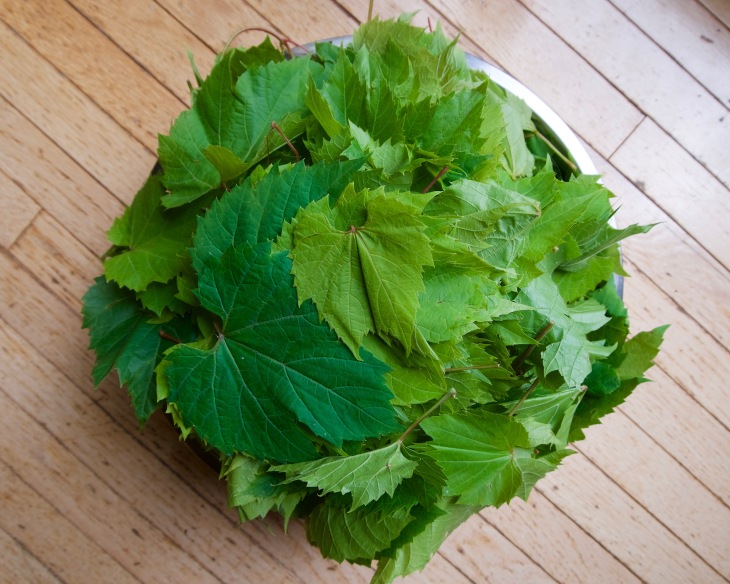
Growing up, my mom did not limit her love of feeding people strictly to our family. Whether we had guests over or friends stopping by to work on a school project, my mom always offered a plate. This was the norm. If we were about to eat dinner and had a friend over, it was always “sit down, eat with us!” And “no, thank you” wasn’t an option.

One day during my fifth grade school year, I had one of my best friends over to hang out and watch TV. It was initially a tough year of transferring to a new school in a new neighborhood, so finally making solid friends made the transition easier. This friend in particular always fed me when I was a guest in her home and I wanted to return the gesture. I wanted to emulate the way my mother always made someone feel at home by offering a hot plate. And even better, that day my mom had cooked a massive pot of Warak Dawali, Stuffed Grape Leaves. Easily makes the list of my Top 5 meals. So, I was excited to share some with my friend.

I stacked the grape leaves on two plates with a generous side of yogurt for dipping and made my way to my bedroom. I enthusiastically told my friend how much she was going to love them and started stuffing my mouth before I can even finish my sentence. When I took a break from inhaling my portion, I looked down at my friend’s plate and realized she had barely touched it. She had one stuffed grape leaf with a small bite taken out it that she shyly wrapped in her napkin. She told me she wasn’t that hungry, but I knew she was being kind and didn’t want to admit she didn’t care for Warak Dawali the way I did. I was so confused in the moment and disappointedly took her nearly full plate back to the kitchen. How can someone not LOVE this dish? How is it not love at first bite for everyone that tries it?
That was possibly the first time I knew our food was different. That not everyone’s parents foraged for herbs and greens around their neighborhood because they couldn’t find them at any local grocery store. That not everyone’s mom searched forest preserves for grape leaf vines to feel a sense of home, to feel a connection to family, to ancestry. And that most people just wouldn’t understand why this dish would become so dear to me, even before I knew it myself.

photo by Kathryn Pauline of Cardamom & Tea
My relationship with foraging has definitely evolved. As a child it was something that I didn’t understand and was a source of embarrassment. But as food became a more integral part of my life and identity, I was forced to dig deeper into those feelings. Why was it so embarrassing or odd? And according to who? Spending more time with my mother and learning how to cook from her opened up my eyes to her own story and struggles. When she felt like a fish out of water as an immigrant, finding something as basic as wild purslane in an alleyway made her feel like she was home again. Even if just for a while. Now I’m eager to learn how to forage from her. Even though more ingredients are accessible to us, I still look forward to the months where we can search for wild herbs or greens around our neighborhood. Or when we make new friends with other foragers while picking grape leaves, I feel like I’m reconnecting to a culture of communal cooking. It’s starting to feel like home for me, too.

Warak Dawali can be an intimidating dish to try to accomplish on your own. There’s many steps to it, not considering the work it takes to forage for leaves. Jarred grape leaves are readily available now in any grocery store that sells Arab or Middle Eastern products. So, in the months that fresh aren’t available, you can still enjoy them.
There is so much variety to the way people make Warak Dawali-actually, pause that thought. There’s a million names to this dish. Warak ‘Anab, Mahshi, Dolma. The list goes on. And depending where you’re from, these names can all mean different dishes. So oddly, this is a case where the English translation has helped me determine the dish someone is actually talking about when Dolma or Mahshi or Dawali is mentioned. Now, back to the way it’s cooked. Some use meat in this dish and some keep it vegetarian. Some pre-cook the filling, while my family opts for the uncooked filling. I personally haven’t come across a stuffed grape leaf I didn’t love. It’s a dish that so many enjoy and with lots of room to make it your own.
As much as I tried to perfect this recipe’s measurements, I found the most consistent thing about this dish is that you will seldom have the perfect amount of grape leaves to filling. You will either have a small pile of grape leaves or some filling left over. Don’t sweat it. You can keep the filling refrigerated for 2-3 days and add it to a stew or soup. You can also freeze both leftover filling or grape leaves for the next time you make Warak Dawali.

fresh grape leaves
Tips for Foraging/Preparing/Storing Grape Leaves:
- Fresh grape leaves are available in the summer season. Depending on the weather and location, you might see them as early as late May/early June all the way through August.
- Earlier in the season, the leaves will be smaller and more tender. Larger, tougher leaves in the end of the season are fine, but will need longer cooking time.
- The leaves grow on vines, but you typically won’t see grapes. You might find the vines draping over trees and other plants. The stems can range in color from brown to green to deep red tones. You can identify them by one side of the leaf being smooth and the opposite having pronounced veins (see photo above).
- Look for leaves that are tender to the touch and do not have any noticeable spotting or holes. That can be a sign of chemical spraying or pests.
- Discoloration and holes can also be a sign of sun damage. You might be eager to pick the first leaves you see, but look for vines that are less exposed to the sun. The vines deeper in the shade will be better quality.
- You can store fresh or blanched grape leaves in the fridge for up to a week before cooking. You can freeze fresh leaves in airtight bags or containers for 3-6 months.
- My dear friend Kathryn has a great blog post on foraging and lots of variations of Dolma on her blog Cardamom & Tea.
- My other dear friend Mai has a great post talking about growing up in Palestine eating stuffed grape leaves and her recipe.

A little note on why you’ll need such a huge pot:
This recipe was developed while my entire family was together under one roof (which doesn’t happen often) and we all prepared a true family-size pot of Warak Dawali. I debated trying to make the recipe more applicable to others, but honestly, I never heard or even saw a small pot of Warak Dawali. It’s the type of dish that is always made in the largest pot you own because everyone loves it, everyone will eat seconds (and thirds) and everyone is going to come together to help make it-so there will be plenty of mouths to feed. Everyone works their way up the ranks when it comes to taking part in making this dish. As a kid, I always prepared the pot and stacked the rolled leaves. Then I graduated up to rolling leaves, learning to make them as neat and perfect as my mother and sisters. I highly encourage getting all hands on deck and sharing in the tradition of communal cooking. If you’re trying to make a slightly more modest amount of Warak Dawali, cutting the recipe in half will still yield plenty for a family dinner or get-together.
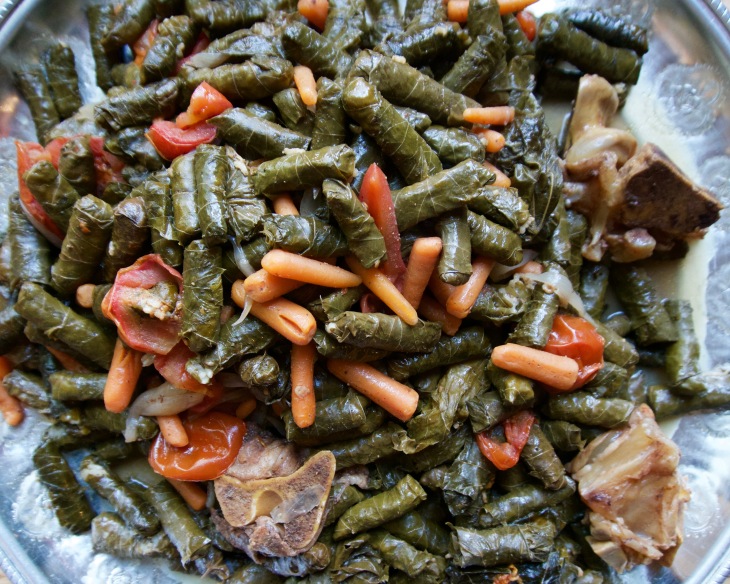
Warak Dawali | Stuffed Grape Leaves
Prep Time: 1 1/2 hours Cook Time: 1 1/2 – 2 hours Yields: 15-20 servings
Ingredients
Grape Leaves & Stuffing:
- 2 pounds (900 grams) fresh grape leaves, unblanched -OR-
- 2-3 jars of grape leaves (1 pound size jars)
- 5 cups (1 kilogram) short grain rice
- 2 pounds (900 grams) ground beef
- 1 large onion, finely chopped
- 1/3 cup parsley, finely chopped (about 1/2 bunch)
- 2 tablespoons 7-spice
- 1 tablespoon black pepper
- 2 tablespoons salt (and additional salt for the broth)
- 1/2 cup of olive oil
- water
- lemon juice or citric acid (optional)
Options for the Bottom of the Pot:
- 4-5 large beef bones (soup bones or shank bones)
- 1 small-medium onion, thinly sliced
- 3 large tomatoes, sliced
- 2-3 cups of baby carrots or carrots, chopped into 3-4 inch pieces
- 2-3 large potatoes, sliced into rounds
- salt
- black pepper
- 7-spice
- olive oil
Instructions
In a large bowl, soak the rice with enough water to completely cover it. Allow the rice to soak for 30-45 minutes while you prepare the grape leaves, filling, and pot.

To prepare fresh grape leaves: Fill a large pot with water and bring to a boil. Blanch the grape leaves in the boiling water for 30-60 seconds until you see the bright green color change to a deep olive green shade. Remove them from the water and place on to a large tray or heat-safe bowl and allow them to cool. Work in batches in order to not overcrowd the pot or drop the temperature of the water. When the grape leaves cool, stack them into small bunches to make the rolling process easier. If you find any leaves with large stems, trim the stems with a pair of scissors.

To prepare the filling: Strain the soaking water from the rice. In a large bowl, combine the rice, beef, onion, parsley, olive oil, and seasonings. Using your hand, work the filling to ensure all the ingredients are incorporated. Taste the filling and adjust the seasoning to your liking.
To prepare the pot: In a large pot, layer the beef bones, onions, tomatoes and carrots. Adjust them to make it as even of a surface as possible for the grape leaves to be stacked on. Drizzle with olive oil and season with salt and black pepper.
Rolling the grape leaves: On a cutting board or flat plate, lay the grape leaf smooth side down. Depending on the size of the grape leaf, place anywhere from 2-3 teaspoons of filling at the bottom of the leaf, spreading it horizontally. Lift the bottom of the leaf over the filling. Then fold each side over the center. While keeping all those sides tucked over the filling, continue to roll the grape leaf from the bottom to the pointy top of the leaf until you have a complete roll. You want it to be slightly tight, but remember the filling needs some room to expand during the cooking process-so, not too tight and not too loose. It takes some practice, but the process is very similar to rolling spring rolls or eggrolls.
Stack the stuffed grape leaves in the prepared pot seam side down. Tuck them close together either in rows or around the pot in a circle pattern. Arrange them neatly and continue to stack them in layers. When complete, lay a thin layer of grape leaves on top to seal everything in. This is a great way to use leaves that were torn or too small/large and couldn’t be rolled.
To cook: Sprinkle 3-4 tablespoons of salt over the rolled grape leaves. Pour hot water gently over the grape leaves, helping the salt dissolve and spread, until there is enough water to cover them all. Place a heavy plate or lid from a smaller pot on top of the grape leaves to weigh them down. Bring the pot to a boil. At this point, taste the liquid for salt and sourness-grape leaves have a natural sour flavor to them, but the strength varies. If necessary, adjust the salt to your liking and sourness by adding lemon juice or a sprinkle of citric acid. Reduce the temperature to low, cover the pot and allow the grape leaves to simmer for 1 1/2 hours.

The Warak Dawali is done when the grape leaves are tender and the filling is cooked through. Test the wellness by picking out a grape leaf and giving it a taste. When it is cooked through, it is best to allow the pot to rest for about 30 minutes. This allows the broth to be further absorbed into the grape leaves and for the temperature to gently reduce before flipping.
Before serving, if there is an excess amount of liquid remaining in the pot, you can either strain off any residual broth or keep it and serve it like that. Just keep that in mind when choosing what to flip the Warak Dawali out onto. Gently spill the Warak Dawali out onto a large platter. Or if you’re brave (and strong) place the platter on top of the pot and flip it so the pot is now upside-down on the platter. Carefully lift the pot to allow the grape leaves to spread across the platter. Serve your Warak Dawali alongside plain yogurt for dipping, spicy condiments, a fresh salad, and warm pita.
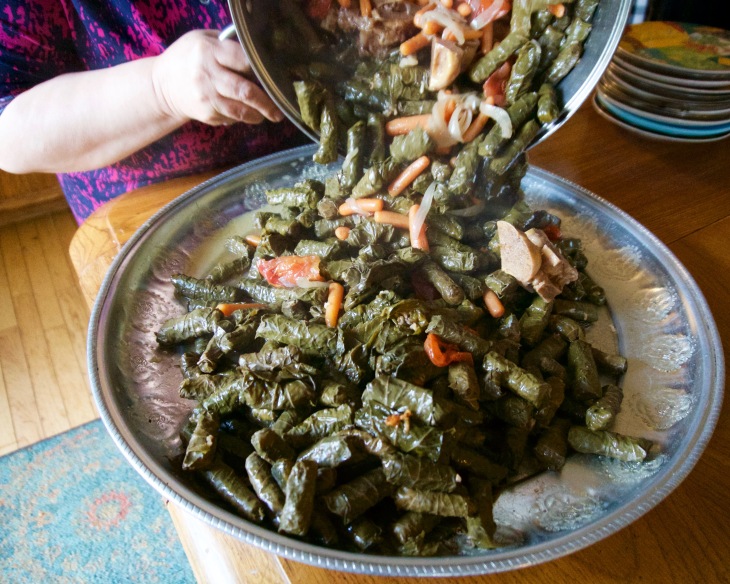

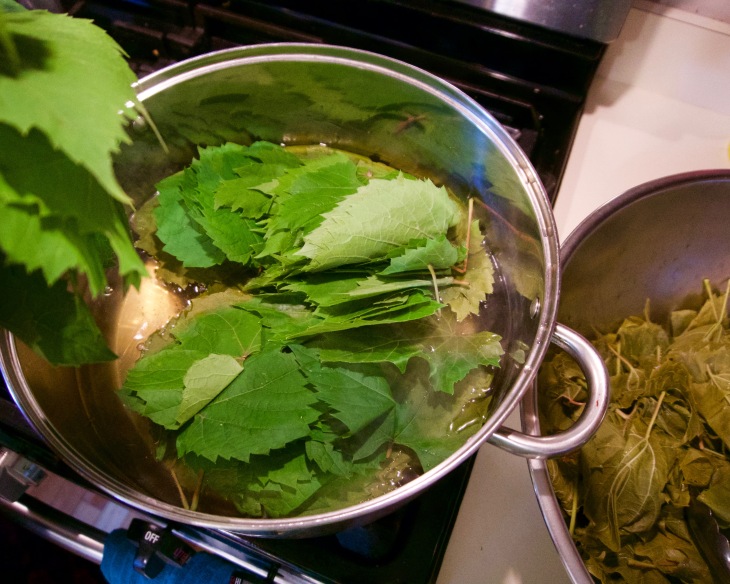


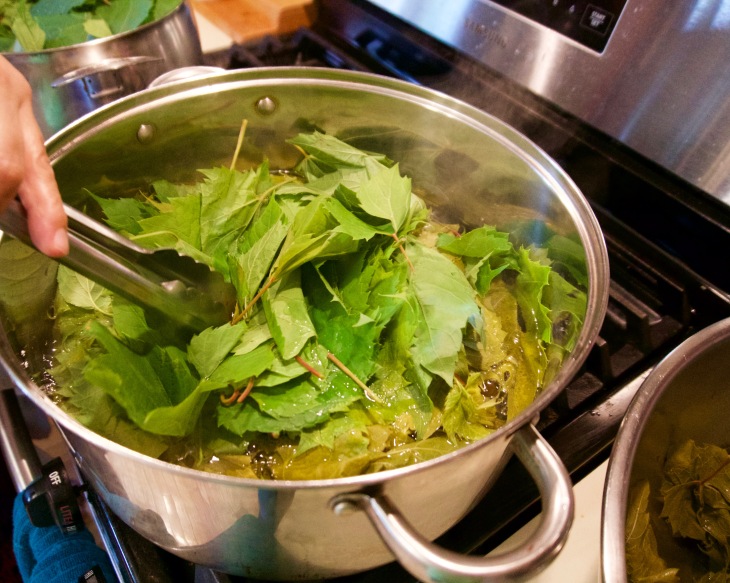




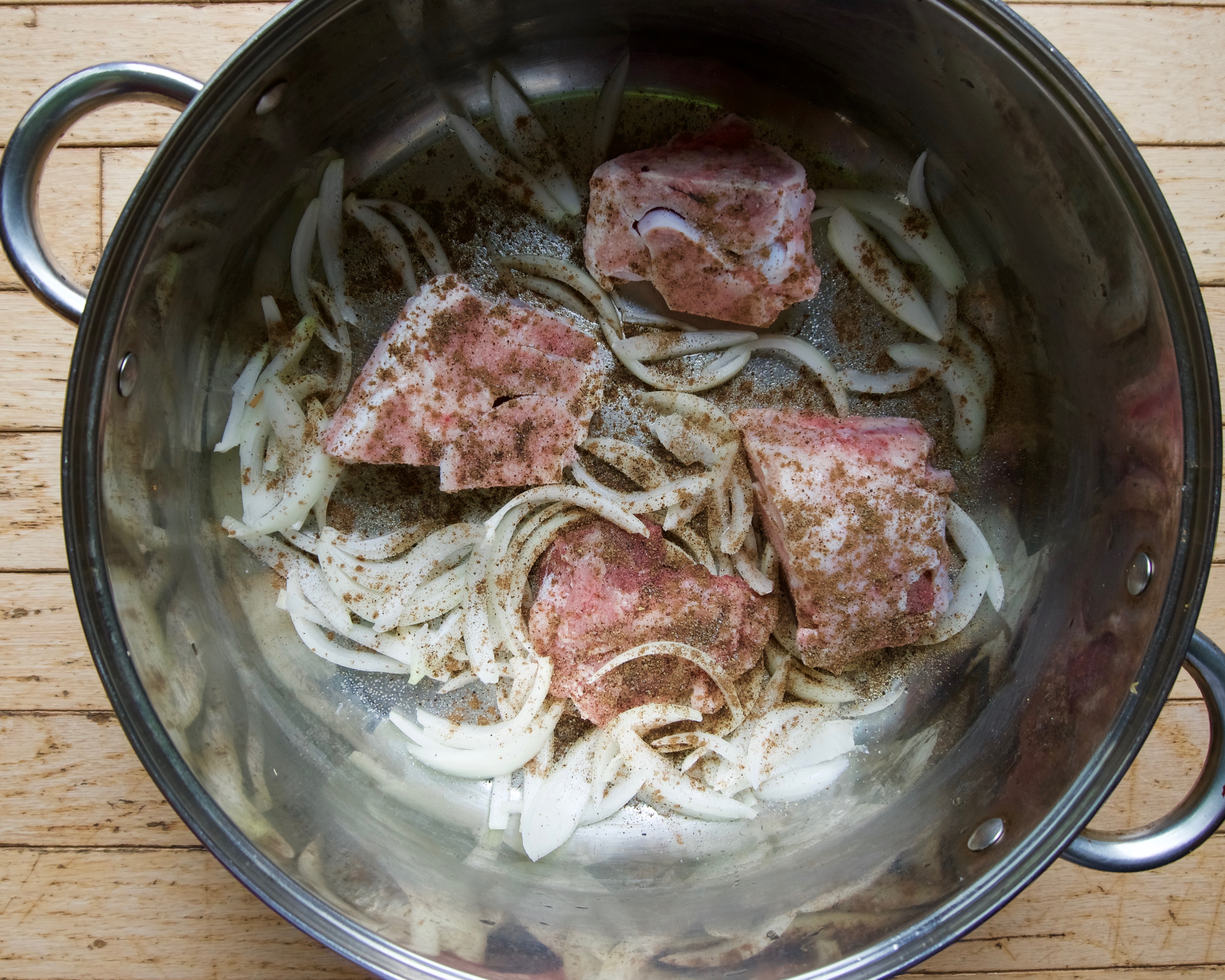




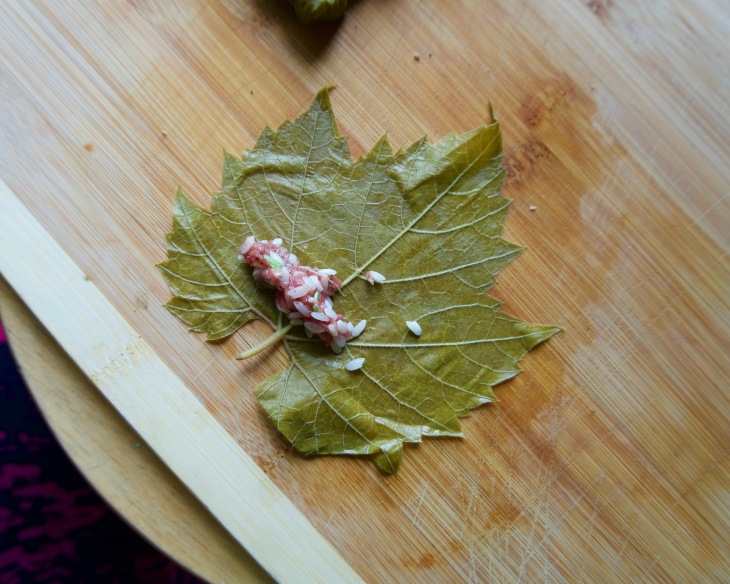


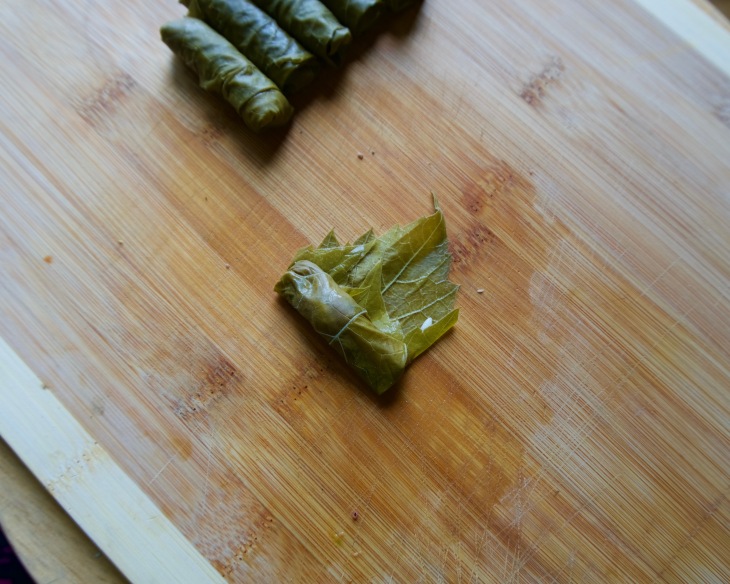
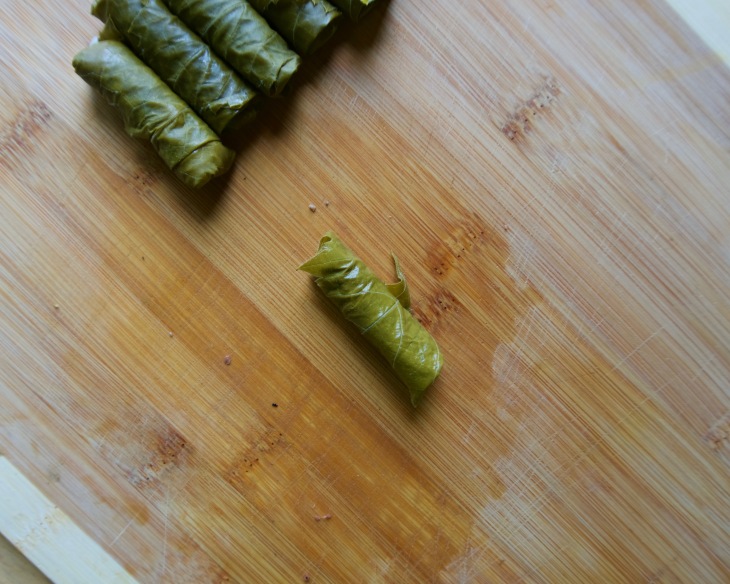

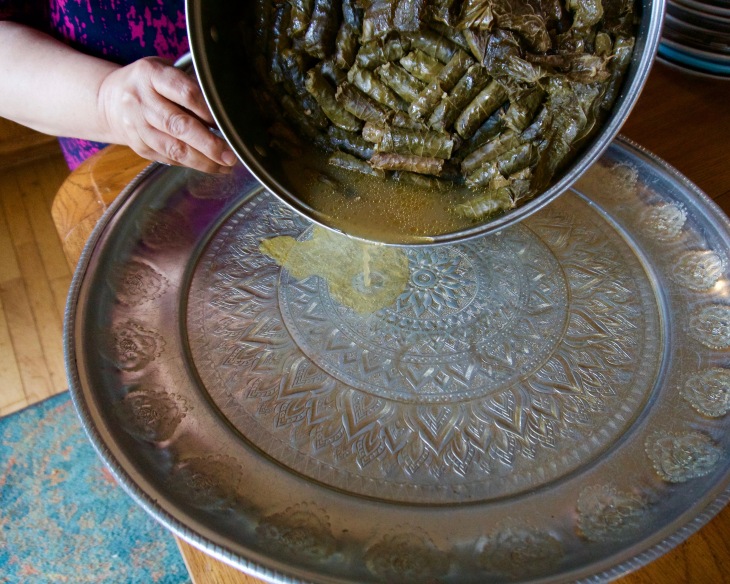

i just love this post so much. I remember having my first experience with learning that my food was different as well. I cannot wait to try this recipe!
Habibti mashallah they look beautifully delicious! ❤️
Love, love, love warak dawali too! Can never get enough, if only it was quicker to make. My Grandmother taught us how to make it using rice, lamb, allspice & cinnamon…so good.
Thank you for this blog, brings back such great memories. Cheers!